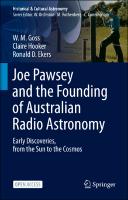Joe Pawsey and the Founding of Australian Radio Astronomy
Early Discoveries, from the Sun to the Cosmos
| dc.contributor.author | Goss, W. M. | |
| dc.contributor.author | Hooker, Claire | |
| dc.contributor.author | Ekers, Ronald D. | |
| dc.date.accessioned | 2023-01-20T16:54:19Z | |
| dc.date.available | 2023-01-20T16:54:19Z | |
| dc.date.issued | 2023 | |
| dc.identifier | ONIX_20230120_9783031079160_34 | |
| dc.identifier.uri | https://library.oapen.org/handle/20.500.12657/60824 | |
| dc.description.abstract | This open access book is a biography of Joseph L. Pawsey. It examines not only his life but the birth and growth of the field of radio astronomy and the state of science itself in twentieth century Australia. The book explains how an isolated continent with limited resources grew to be one of the leaders in the study of radio astronomy and the design of instruments to do so. Pawsey made a name for himself in the international astronomy community within a decade after WWII and coined the term radio astronomy. His most valuable talent was his ability to recruit and support bright young scientists who became the technical and methodological innovators of the era, building new telescopes from the Mills Cross and Chris (Christiansen) Cross to the Parkes radio telescope. The development of aperture synthesis and the controversy surrounding the cosmological interpretation of the first major survey which resulted in the Sydney research group's disagreements with Nobel laureate Martin Ryle play major roles in this story. This book also shows the connections among prominent astronomers like Oort, Minkowski, Baade, Struve, famous scientists in the UK such as J.A. Ratcliffe, Edward Appleton and Henry Tizard, and the engineers and physicists in Australia who helped develop the field of radio astronomy. Pawsey was appointed the second Director of the National Radio Astronomy Observatory (Green Bank, West Virginia) in October 1961; he died in Sydney at the age of 54 in late November 1962. Upper level students, scientists and historians will find the information, much of it from primary sources, relevant to any study of Joseph L. Pawsey or radio astronomy. This is an open access book. | |
| dc.language | English | |
| dc.relation.ispartofseries | Historical & Cultural Astronomy | |
| dc.subject.classification | thema EDItEUR::P Mathematics and Science::PG Astronomy, space and time | en_US |
| dc.subject.classification | thema EDItEUR::P Mathematics and Science::PD Science: general issues::PDX History of science | en_US |
| dc.subject.classification | thema EDItEUR::T Technology, Engineering, Agriculture, Industrial processes::TJ Electronics and communications engineering::TJF Electronics engineering::TJFC Electronics: circuits and components | en_US |
| dc.subject.classification | thema EDItEUR::P Mathematics and Science::PD Science: general issues::PDD Scientific standards, measurement etc | en_US |
| dc.subject.other | Radio astronomy, history | |
| dc.subject.other | Telescope arrays | |
| dc.subject.other | Joseph L. Pawsey, founder of Australian radio astronomy | |
| dc.subject.other | 2c survey | |
| dc.subject.other | Radiophysics Laboratory | |
| dc.subject.other | Radar research in World War II | |
| dc.subject.other | Ionosphere research | |
| dc.subject.other | Solar radio astronomy | |
| dc.subject.other | Aperture synthesis | |
| dc.subject.other | Radio cosmology book | |
| dc.title | Joe Pawsey and the Founding of Australian Radio Astronomy | |
| dc.title.alternative | Early Discoveries, from the Sun to the Cosmos | |
| dc.type | book | |
| oapen.identifier.doi | 10.1007/978-3-031-07916-0 | |
| oapen.relation.isPublishedBy | 6c6992af-b843-4f46-859c-f6e9998e40d5 | |
| oapen.relation.isFundedBy | 260fc86b-ca5f-4a07-b22c-50968b3f3fa1 | |
| oapen.relation.isbn | 9783031079160 | |
| oapen.imprint | Springer International Publishing | |
| oapen.pages | 815 | |
| oapen.place.publication | Cham | |
| oapen.grant.number | [...] |

